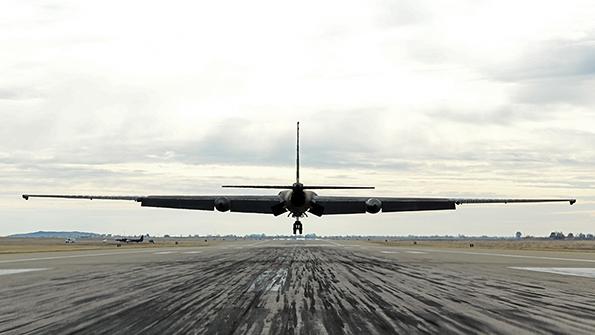
A U.S. Air Force demonstration of an artificial intelligence “co-pilot” aboard a Lockheed Martin U-2S demonstrated another step in the military’s goal to transfer more in-flight decision-making to computers.
The artificial intelligence (AI) co-pilot on the Dec. 16 flight had no seat onboard the U-2S but did have a call-sign: “ARTUμ.” During the practice mission, ARTUμ and the pilot shared use of the U-2S’ Raytheon Advanced Synthetic Aperture System (ASARS) radar. The human pilot used the sensor for a purely defensive role, scanning the skies for hostile aircraft. Meanwhile, the Air Force assigned the offensive role to the ARTUμ, which mined ASARS’ raw data for evidence of enemy missile launchers.
- Space Force tasked to apply artificial intelligence for operations
- “ARTUμ” shared radar control with pilot during practice mission
The AI program functioned at a higher level than a typical software filter for a radar search. ARTUμ decided when to devote the radar to solely searching for missiles, rather than for self-protection. Pilots normally command the computer to perform functions to support a mission, but in this case a software program, not the human, functioned as the mission commander. In this way, the Air Force gave ARTUμ more authority than its partial namesake, the R2D2 droid in the “Star Wars” movies.
“Luke Skywalker certainly never took such orders from [his] X-Wing sidekick,” Will Roper, assistant secretary of the Air Force for acquisition, technology and logistics, wrote in an opinion column published in Popular Mechanics after the flight.
The demonstration of an AI application running on an aircraft that traces its lineage to the first flight of the U-2C in 1955 capped a series of events in 2020 that highlighted the Air Force’s recent emphasis on using software—rather than a new engine or airframe—to drive breakthroughs in aircraft performance.
Last August, DARPA’s Alpha-Dogfight Trials showed that an AI agent could dominate a human pilot of a Lockheed Martin F-16, but under artificial constraints of a simulated engagement. The U-2S demonstration also lacked constraints imposed by a real-world situation, with an adversary deploying countermeasures aimed at using AI’s currently rigid, rules-based architecture to fool it.
“The U-2 AI flight isn’t a finish line at all,” Roper said in a follow-up meeting with journalists. “It’s just a starting pistol.”
The Air Force Research Laboratory plans to push AI applications for military aircraft further in 2021. The Skyborg program is seeking to apply an AI-enabled autonomous control system being integrated by Leidos on multiple unmanned aircraft systems. The software for the AI agent is likely to build on DARPA’s Collaborative Operations in Denied Environment (CODE) program, which demonstrated an AI pilot on a flying General Atomics Aeronautical Systems Inc. MQ-9B in October.
The series of demonstrations benefit from the ability of any AI program to perform millions of simulations in a virtual environment before attempting a flight.
In the case of the ARTUμ, the Air Force used the μZero gaming program, which is primarily known as the leading AI algorithm for playing chess. The μZero software was trained by the Air Force’s U-2 Federal Laboratory to operate a radar by running more than 1 million simulated missions over a period of several weeks, Roper says.
The Air Force’s software developers also imposed constraints on the ARTUμ’s authority. The AI agent had control over the radar but not the sensors on board the aircraft. As the aircraft’s passive electronic intelligence receivers are often used to show the radar where to look, it is possible that this self-imposed constraint reduced performance. At this early stage of AI’s application in the aviation community, however, the Air Force prioritized winning the human pilot’s trust over maximizing the performance of the software controls.
Although an initial step, ARTUμ is the inspiration for AI applications in other parts of the military, including for the nascent Space Force’s “Kobayashi Maru” software laboratory.
“Ultimately, what I want Space Force to be able to do is the same thing that we’ve done in the U-2,” Roper says. “And I gave Kobayashi Maru that task this week: having an AI co-pilot for space operations. The reason I think that’s really important is that space is going to be unlike any other domain, in that physics is going to make it far more predictive.”





